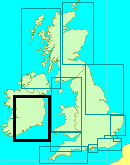You are viewing the expanded version of this Harbour,
for faster browsing
use the regular version here
Rogerstown Inlet & Rush Harbour
Courtesy Flag
Irish TricolourWaypoint
NoneCharts
AC44 Nose of Howth to Ballyquintin Point, AC 633 + SC5621 Rogerstown Inlet, Imray C62 Irish seaRules & Regulations
None KnownHazards
Rogerstown has a bar across its entry channel and is only approachable by keeled boats a couple of hours either side of HW. Rush harbour dries completely and has a reef to starboard of the entrance to the cove which dries from half tide onwards.Tidal Data Times & Range
As Malahide; HW is Dublin +0005; MHWS 4.4m MHWN 3.2m MLWN 1.1m MLWS 0.5m; Streams off shore in Lambay Sound reach 2.5 knots at Springs which run North from 4½ hours before HW Dublin to 1½ hours after.This site is designed for slower, roaming broadband connections, like you would get at sea, so it needs JavaScript enabled to expand the text.
General Description
Contacts Rush Sailing Club tel +353 (0)18430695
The shore on the Irish coast opposite Lambay Island is a long strand stretching from the Martello Tower at Rush as far south as Portmarnock Point opposite Ireland’s Eye. The coast is penetrated by two river estuaries, the Rogerstown Inlet and the Malahide Inlet both of which host the sailing fraternity; The Rogerstown Inlet has its Sailing Club and the Malahide Inlet its marina which is covered in a separate entry and both have interesting buoyed channels.
North of the Rogerstown Inlet the strand is backed by the town of Rush which extends north of its Martello tower and forms the backdrop to its “North” beach, whist the beach between the tower and the inlet is the “South” beach; the small promontory between these two beaches has a small drying harbour on its north side known as Rush harbour.
This harbour dries completely at low tide exposing the unmarked, dangerous rocky reef extending out from its North breakwater; this reef is covered either side of HW and will not be obvious in settled weather but any sea at all will cause breakers around it and highlight its presence.
The harbour wall is occupied by small fishing vessels (mainly pot layers) and there are long fore and aft moorings laid out for the other permanent residents of the harbour. Obviously it is totally unsuitable in easterly weather unless you can get to dry out alongside the pier and even then it will be uncomfortable in anything above a F3-F4. An alternative would be to lie to your anchor outside the harbour in good holding and land ashore by dinghy.
Further South it’s an entirely different situation; at low water the beach stretches out in almost a straight line between the Martello towers at Rush and Cable Rocks, the river estuary drains into the middle of this beach and extends back through a lagoon almost three miles inland.
Over the beach the river channel varies in depth and dries entirely in places; from June to September the Sailing Club lays out marker buoys and a fairway buoy but at other times the channel is not marked. There are normally four sets of buoys leading into the anchorage opposite the Sailing Club’s premises on the north shore and the channel becomes obvious as it is bounded by yachts and dinghies moored just outside the channel. There is limited space for anchoring but the Sailing Club may be able to offer a spare mooring.
Having taken the trouble to find your way here you will be tempted to stay a while; it’s a pleasant, rural spot with just enough in the way of amenities, especially if you don’t mind a wee walk in to Rush itself which caters for visitors during the season.
Here's a short Drone sequence to give you an idea of what to expect.
Approach
The approach to Rush harbour is unmarked and without any lead in marks;
The best bet is to approach on a line parallel (approx 255°T)to the north breakwater about 50m to the right of the end of the pier.
When attempting an entry to the Rogerstown Inlet it is imperative to identify the fairway marker and make your approach on a heading of about 300°T. If visibility is such that you are unable to see the buoys marking the channel then it would very unwise to plod on in the hope that they will “turn up.” Anyway, assuming that you can see the buoys, the rest is simple; you’ll be able to see the yachts moored off the Sailing Club but be careful, although they do have fin keeled yachts, you can’t assume that what you are looking at draws the same water as you or you may end up on the putty beside a drop keeler!!
Berthing, Mooring & Anchoring
Discussed above
Facilities
The Rush Sailing Club has a bar and changing facilities and is open in the evenings at the weekend and on Wednesdays. For provisions and petrol you will have to walk in to the main street of the town which is the street beside the church marked on AC 0633-6; quite a way but there is a petrol station there as well.
Eating, Drinking & Entertainment
Apart from the Sailing Club bar there is not much here so you will have to seek entertainment and refreshment in the town.
Links
|
Your Ratings & Comments








